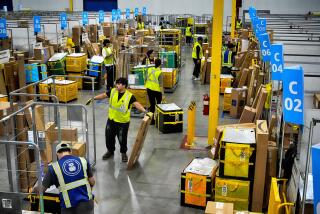Economic Index Rises 0.6%, Suggests Continued Growth
WASHINGTON — The index of leading economic indicators, the government’s main barometer of economic activity, rose a strong 0.6% in December, suggesting more growth ahead for the U.S. economy after six years of expansion.
The increase, reported by the Commerce Department Wednesday, was in line with expectations and was the latest move in a seesaw pattern of monthly rises and falls that began last spring. The index of leading economic indicators has reversed course in each of the past nine months, showing little forward momentum. December’s increase left the index at 194.6% of its 1967 base of 100, up a slim 2% from the same month a year ago.
Economists welcomed the continued vacillation as a precursor to slower, more sustainable growth during the economic expansion’s seventh year, saying restraint would help keep inflation in check without threatening a serious downturn.
“The economy is going to be slowing down but there is no recession on the horizon,” said economist David Wyss of Data Resources Inc. in Lexington, Mass.
Wyss predicted that by the middle of next year, growth would slow enough for the Federal Reserve Board to ease its tight grip on the money supply. Since March, the central bank has been pushing up interest rates to dampen inflationary pressure and to slow economic growth.
Samuel D. Kahan, chief economist for Kleinwort Benson Government Securities Inc. in Chicago, said the report’s saw-toothed performance “tells you that there is not a boom building. It suggests maybe somewhat slower growth in the next couple of quarters, but it most assuredly does not point to any kind of a recession.”
“If you look at what the index has been doing over the last year, it says that the economy is going to slow down,” said Bruce Steinberg, senior economist at Merrill Lynch Capital Markets in New York.
The economy grew a robust 3.8% in 1988, but the slowest quarterly performance in two years was recorded during the October-December period, when the increase in the gross national product was held to an annual rate of 2%.
President Bush plans to adopt his predecessor’s forecast that the economy will grow at a 3.2% rate in 1989, but many private economists are making more pessimistic predictions for the coming year.
Six of the nine separate measures of economic activity that make up the index were higher in December, led by a sharp jump in new orders received by manufacturers of consumer goods, the department said.
The remaining five components of the leading index that contributed to its increase were stock prices, business investment in new plant and equipment, sensitive materials prices, building permits and the money supply.
One Indicator Unchanged
Two indicators--average workweek and initial jobless claims--were negative in December. The ninth indicator, delivery times of supplies ordered by manufacturers, was unchanged.
The index of coincident indicators, which measures current economic activity, rose 0.7% in December after rising 0.1% in November, while the index of lagging indicators, which measures past economic activity, rose 0.8% in December after rising 0.9%.
The leading index fell 0.2% in November, rose 0.5% in October and fell 0.4% in September.
Although the index’s recent waffling was seen by many as a sign of slower growth ahead, Annable said December’s strong showing suggests that “this economy still has a lot of momentum going into the first quarter of the year.”
“You’ve got all the factors in line to make this a pretty good growth year,” he said. “The economy is slowing, but it’s not slowing down dramatically.”
More to Read
Inside the business of entertainment
The Wide Shot brings you news, analysis and insights on everything from streaming wars to production — and what it all means for the future.
You may occasionally receive promotional content from the Los Angeles Times.










